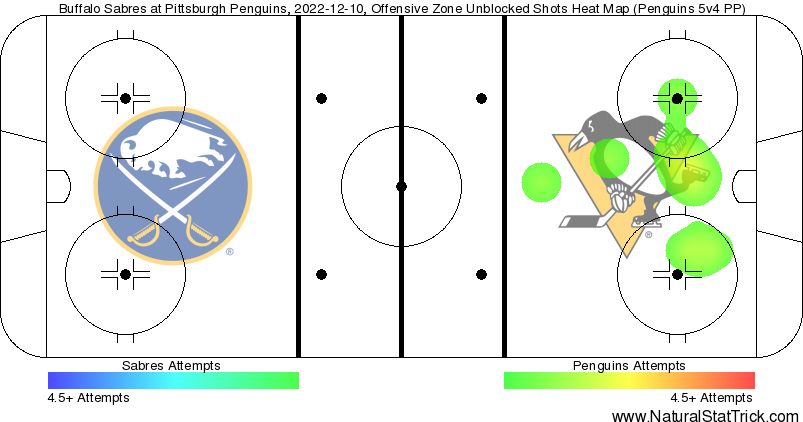It wasn't that long ago that the Penguins seemingly couldn't buy a power play goal.
The Penguins had a decent start on the man advantage to start the season, then it was the end of October when things started to fall apart.
From Oct. 29 (the game in Seattle to close out the western road trip) through the end of November (ending with the OT loss against Carolina on Nov. 29), the Penguins went just 4-for-41 on the power play, a 9.8% success rate that ranked dead last in the league during that timeframe. Their record during that stretch was pretty unimpressive as well, going 7-5-3.
Since then the Penguins have gone on a five-game win streak, including Saturday's 3-1 win over the Sabres at PPG Paints Arena.
It's no surprise that the power play's resurgence coincides with the beginning of that streak.
The Penguins have gone a combined 7-for-23 on the power play in their last five games, recording at least one goal on the man advantage in each win. Their success rate on the power play over this stretch is 30.4%, the ninth-best rate in the league during that time.
The Penguins opened the scoring Saturday on the power play, and it's a goal that exemplifies one of the big reasons for this turnaround on the power play: A shot-first mentality.
It was the Penguins' second power play of the game, coming after Ryan Poehling drew a high-sticking call on Victor Olofsson. Sidney Crosby took a shot that was stopped by Sabres goaltender Ukko-Pekka Luukkonen, and the rebound popped right out to Evgeni Malkin. Luukkonen stopped Malkin's shot, and the rebound went straight to Rickard Rakell. A third rapid-fire shot in the sequence was too much for Luukkonen, and Rakell sniped his shot to give the Penguins the lead:
"We have a shot-first mentality," Rakell told me of the power play's success as of late. "We have a good plan going into the power play. I think we got some momentum from the first power play, and it just carried us on to the second one. We just kept making those plays, shooting with them. So it was nice to see one go in."
The stats back up that development. During the aforementioned 4-for-41 stretch, the Penguins averaged 93.99 shot attempts per 60 minutes of power play time, the 24th-best rate in the league. Their rate of unblocked shot attempts (64.67 per 60) ranked 27th in the league. They averaged 41.39 shots on goal per 60 minutes, the 30th-best rate in the league.
Over the last five games the Penguins are averaging 125.69 shot attempts per 60 minutes of power play time, the fifth-best rate in the league. Their rate of unblocked shot attempts (95.16) ranks 10th. They're averaging 73.62 shots on goal per 60 minutes, the sixth-best rate in the league in that span.
They're putting more pucks on net, creating more rebound opportunities for themselves and more movement for the whole unit, and it's paying off.
Mike Sullivan said that he couldn't pinpoint any one specific reason for the turnaround, but said that confidence is playing a big part in the team's success on the power play.
"Their confidence level is much higher," Sullivan said. "When you have some success, I think that helps build the confidence of the guys going on the ice. When they're confident like that, they're able to get themselves from a mindset standpoint in an instinctive mode."
When your top unit forwards with offensive instincts like Crosby, Malkin, Rakell and Jake Guentzel, those instincts translate into goals.
"When they act on their instincts, they're elite players," Sullivan said of the players on the power play. "They see it, they feel it, they make good decisions with the puck. They're crisp with their passing. They're not robotic or deliberate things of that nature. The puck moves quickly, their decisions are timely."
When I asked Rakell if he thinks what changed the most between that earlier stretch and this five-game win streak, he expressed a similar sentiment. The team is shooting more, it's paying off, and that gives them the confidence they need to keep making those plays. It's like a cycle.
"It's just the shooting mentality," he said. "I think everyone on the power play feels like they are a threat out there. We're not playing on the outside, or not knowing where our outs are when we're getting pressured. That's a big part of it."
Looking where shots attempts were coming from on Saturday, you can see that the Penguins weren't being forced to the outside. Everything either came from Jeff Petry or Kris Letang at the point, or the forwards in some of more prime shooting locations:

Beyond the shooting and the confidence, Sullivan said that there's a lot that is contributing to the success the power play is having. He mentioned the good work they've been getting from their net-front presences -- that's primarily Guentzel on the top unit and Jeff Carter on the second unit -- to take away the sight lines of goaltenders. He also mentioned the support players that allow the Penguins to make release plays and get out from under pressure.
"There's a whole number of things that I think add up to the success that they're enjoying right now," Sullivan said. "But I think first and foremost, it starts with their own confidence. And then once that happens, these guys have some of the best instincts in the game."
It's not difficult to see that both special teams groups have been a major factor in this run the Penguins have been on. If they can keep up this success on the power play (and the penalty kill), their record will continue to follow.

